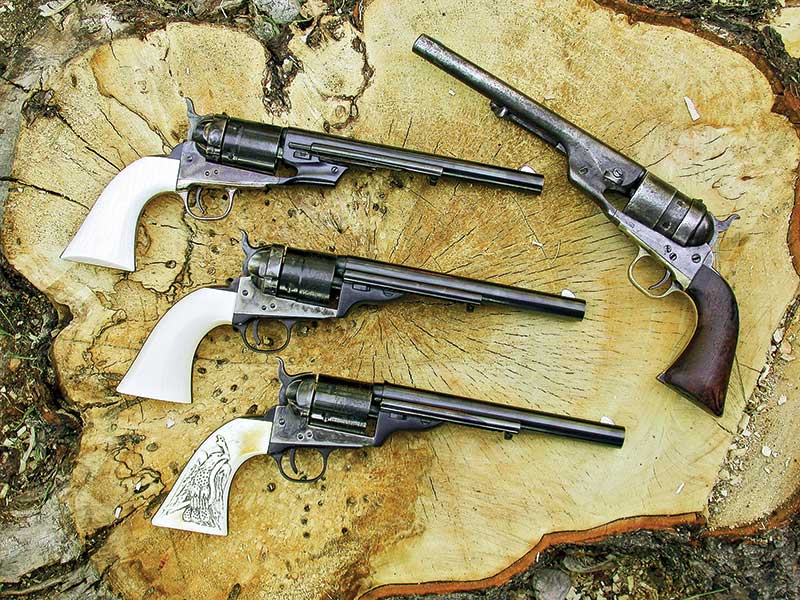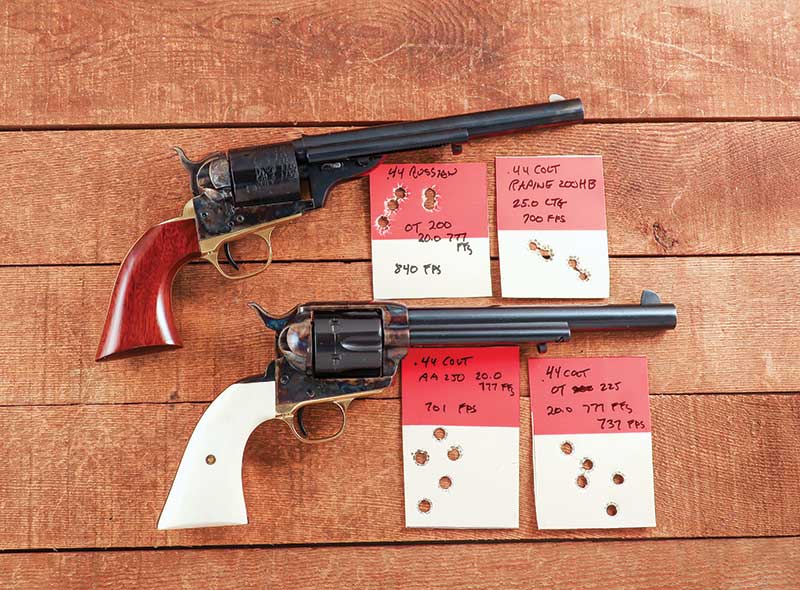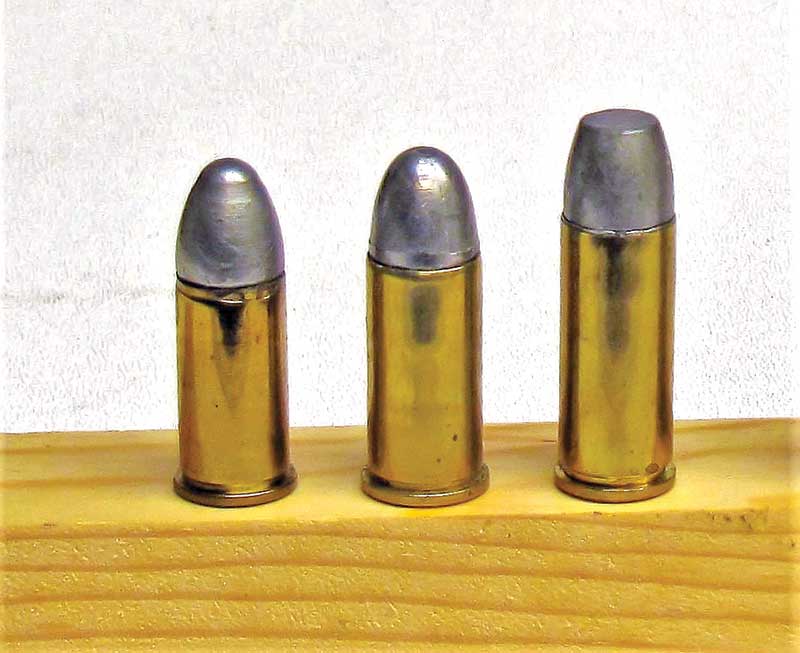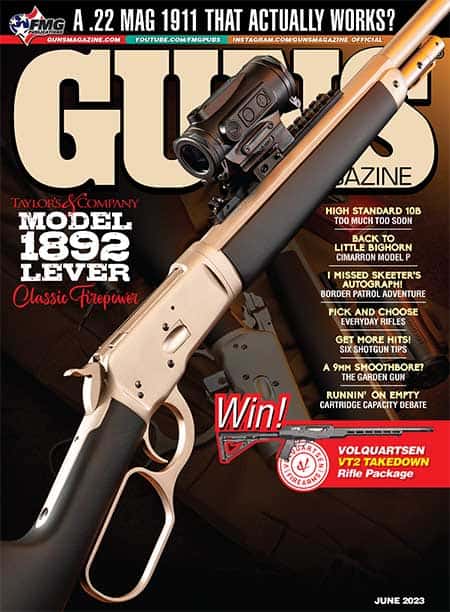Black Powder And The .44 Colt
Reloading A Short-Lived Military Cartridge
Sam Colt’s percussion revolvers were so successful he was blinded to the future and before he died he set the course for the Colt Company. Ignoring the newfangled brass cartridges such as the .22 of Smith & Wesson’s tip-up, seven-shot, single action revolver and the .44 of B. Tyler Henry’s 1860 lever gun, Colt instead continued producing percussion firearms. Sam Colt was positive shooters would always prefer to load their own ammunition using powder, ball and cap and there was no future for fixed ammunition. He was definitely wrong!
However, Smith & Wesson was living in the future and in late 1869 brought forth the first big bore cartridge firing sixgun, the Model #3 .44 S&W American, a top-break revolver with automatic ejection of fired cartridges when opened. The future had arrived for Smith & Wesson while Colt was stuck in the past.
Stopgap Conversions
Colt was ready to pay attention. They needed to come up with a revolver accepting brass cartridges at the rear of the cylinder but there was a problem. The Rollin White patent, a patent Colt had turned down, was now controlled by Smith and Wesson but it would run out shortly. Colt needed to do something while waiting.
Colt Cartridge Conversions were based on the 1860 Colt Army percussion revolver which used a 0.451″ round ball. When the switch was made to a cartridge-firing system, the 1860 Army .44 was chambered for the .44 Colt, a round using a heel-type bullet whose base was smaller in diameter than the remainder, resulting in a bullet the same diameter as the outside of the case, much like today’s .22 rimfire rounds.
The original loading for the .44 Colt was 21 grains of black powder with a thick lube wad between a conical bullet and powder. Bullets weighed approximately 208 grains and muzzle velocity was around 750 FPS. The U.S. Army adopted the .44 Colt as one of its official cartridges for two years. The last transitional Colt sixgun was the 1871–72 Open-Top. The Cartridge Conversions were performed on existing 1860 Army revolvers in the field as well as being assembled from parts at the Colt factory. However, the 1871–72 Open-Top was a completely new sixgun which would morph into the Colt Single Action Army.
The .44 Colt cartridges were produced beginning around 1871 with a case length of 1.050″–1.120″ when Colt was furnishing the United States Military with factory conversions on the 1860 Army. As an aside, original ammunition would also fit the Remington Model 1875 chambered in .44 Remington. The .44 Colt did not last long as the official military cartridge since it was replaced two years later by the .45 Colt.
Currently replicas are available as the Richards Conversion, Richards-Mason Conversion and the 1871-72 Open-Top versions all chambered in a modernized version of the .44 Colt. As far as I know Black Hills Ammunition was the first to produce modern .44 Colt loads. They used shortened .44 Special brass and also reduced the diameter of the rim. Those early rounds were still headstamped .44 Special.
The reason for reducing the diameter of the rim of the .44 Colt brass is due to the diameter of the 1860 Army cylinder. The diameter had to be reduced to keep the rims from overlapping each other. It was soon found .44 Russian rounds would chamber in .44 Colt cylinders. However, the rims would overlap and can only be used by loading every other chamber.
So, any of the original .44 Colt replica Cartridge Conversions can only be used with .44 Colt brass, which is now available from Starline properly head stamped, or for the very short-lived .44 cartridge known as “4-In-1,” which used a cartridge case the same length as the Russian but with the rim of the .44 Colt.
Although early Colt-replica Cartridge Conversions were built on cylinders the same size as the 1860 Army and chambered in .44 Colt, these could not be used with the .44 Russian or .44 Special. The last two Cartridge Conversions I have purchased chambered in .44 Colt now have larger diameter cylinders and can be used also with .44 Russian and .44 Special loads. Someone needs to know just what they want their particular Cartridge Conversion to handle and make sure by talking to the distributor just which version they are getting.
Loads
For loading the .44 Colt, either .44 Russian or .44 Special loading dies may be utilized. The shell holder normally works even with the smaller rim of the .44 Colt case. For loading black powder in the .44 Colt, I use the same procedures as outlined in previous installments with most loaded with around 20–25 grains of powder.
Sample loads and their muzzle velocities used with the Oregon Trail 200-grain RNFP are 21.5 grains of Clean Shot FFFg for 750 FPS; 20 grains of Triple-Seven FFg, 785 FPS. Switching to the RCBS #44-200 FN designed for the .44-40 at around 200 grains in weight gives the following — 25 grains Goex FFFg results in 850 FPS; 25 grains Pyrodex, 875 FPS; 25 grains Hodgdon’s SELECT, 840 FPS; and my most accurate load using this bullet is 25.0 grains Goex FFg for 770 FPS and just over a 1″ group. All bullets are lubed with Lyman Black Powder Gold.
The Rapine Hollow Point bullet gives excellent accuracy with 25.0 grains of Goex Cartridge at 725 FPS or the same charge of Goex FFg for 750 FPS for groups just over 1″ and the AA 250-grain bullet with 20.0 grains of Triple-Seven FFg at 785 FPS in the same accuracy range. These are not light loads by any means and certainly can serve as everyday packing loads whether in a Cartridge Conversion or a .44 Special sixgun.
Shooting .44 Russian or .44 Colt loads in the longer .44 Special cylinder needs to be experimented with to see how accurate the loads will be. Some of these loads will actually rival the .44 Special when it comes to accuracy.







